Transport in Hungary relies on several main modes, including transport by road, rail, air and water.

Nagykörút or Grand Boulevard is one of the most central and busiest parts of Budapest, a major thoroughfare built by 1896, Hungary's Millennium. It forms a semicircle connecting two bridges of the Danube, Margaret Bridge on the north and Petőfi Bridge on the south. Usually the part inside and around this semicircle is counted as the city centre of Budapest.
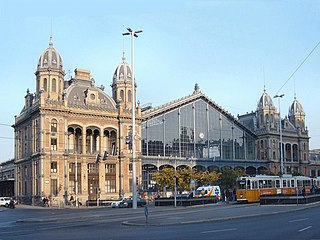
Nyugati pályaudvar, is one of the three main railway terminals in Budapest, Hungary. Known to locals and foreigners alike simply as Nyugati, the station is on the Pest side of Budapest, accessible by the 4 and 6 tramline and the M3 metro line.

Budapest-Déli station, known to locals and foreigners alike simply as the Déli is one of the three main railway stations in Budapest, Hungary.

Budapest Keleti (eastern) railway station is the main international and inter-city railway terminal in Budapest, Hungary.

Keleti pályaudvar is a transfer station on M2 and M4 lines of the Budapest Metro.
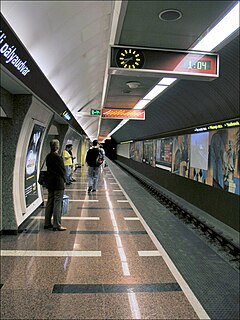
Déli pályaudvar is the western terminus of the M2 (East-West) line of the Budapest Metro. It serves the Déli Railway Station and its vicinity.
There are three main railway stations in Budapest:
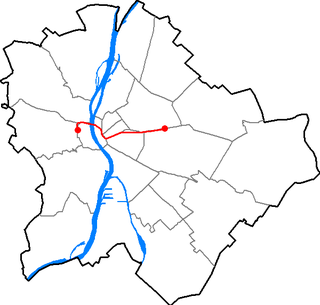
Line 2 is the second line of the Budapest Metro. The line runs east from Déli pályaudvar in north-central Buda under the Danube to the city center, from where it continues east following the route of Rákóczi út to its terminus at Örs vezér tere.
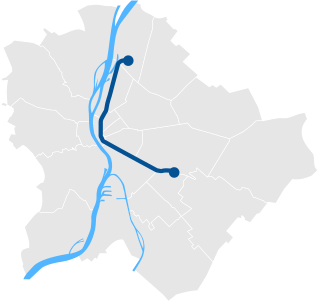
Line 3 is the third and longest line of the Budapest Metro. It runs in a general north-south direction parallel to the Danube on the Pest side, roughly following Váci út south from Újpest to the city center, then following the route of Üllői út southeast to Kőbánya-Kispest. Its daily ridership is estimated at 626,179. Like Line 1, it does not serve Buda.

Line 4 is the fourth line of the Budapest Metro. It opened on 28 March 2014.

Memento Park is an open-air museum in Budapest, Hungary, dedicated to monumental statues and sculpted plaques from Hungary's Communist period (1949–1989). There are statues of Lenin, Marx, and Engels, as well as several Hungarian Communist leaders. The park was designed by Hungarian architect Ákos Eleőd, who won the competition announced by the Budapest General Assembly in 1991. On public transport diagrams and other documents the park is usually shown as Memorial Park.

Újbuda is the 11th district of Budapest, Hungary. It is the most populous district of Budapest with 137,426 inhabitants (2008). Until the 1890s, Újbuda's present territory was a field south of the historical town of Buda. The construction of a new residential area started in the 1900s, the present district was formed in 1930. From 1880 to 1980, Újbuda's population increased from 1,180 to 178,960. There are boulevards, avenues with tram lines, and communist-era housing estates in the district. Line 4 of the Budapest metro passes through Újbuda.

Kelenföld railway station is Budapest's fourth busiest railway station. Opened in 1861, it is situated south-west of the city centre, in Újbuda or District XI in the suburb Kelenföld.

The tram network of Budapest is part of the mass transit system of Budapest, the capital city of Hungary. The tram lines serve as the second most important backbone of the transit system, carrying almost 100 million more passengers annually than the Budapest Metro.
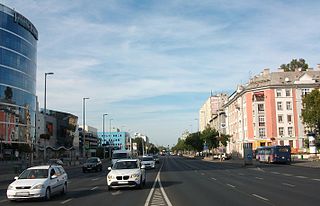
Váci út is one of the widest and busiest avenues in Budapest, Hungary. It is about 12 kilometers long and has four to eight traffic lanes.

Hungária körgyűrű is the longest and busiest boulevard, also the widest city street in Budapest, Hungary. It's 13 km long and has 6-10 traffic lanes with a rapid tram line on the median of the boulevard. It consists of three parts: Róbert Károly körút, Hungária körút and Könyves Kálmán körút.

Trams in Szeged are an important part of the public transport network serving Szeged, Hungary. In operation since 1884, the network presently has four full tramlines.



















